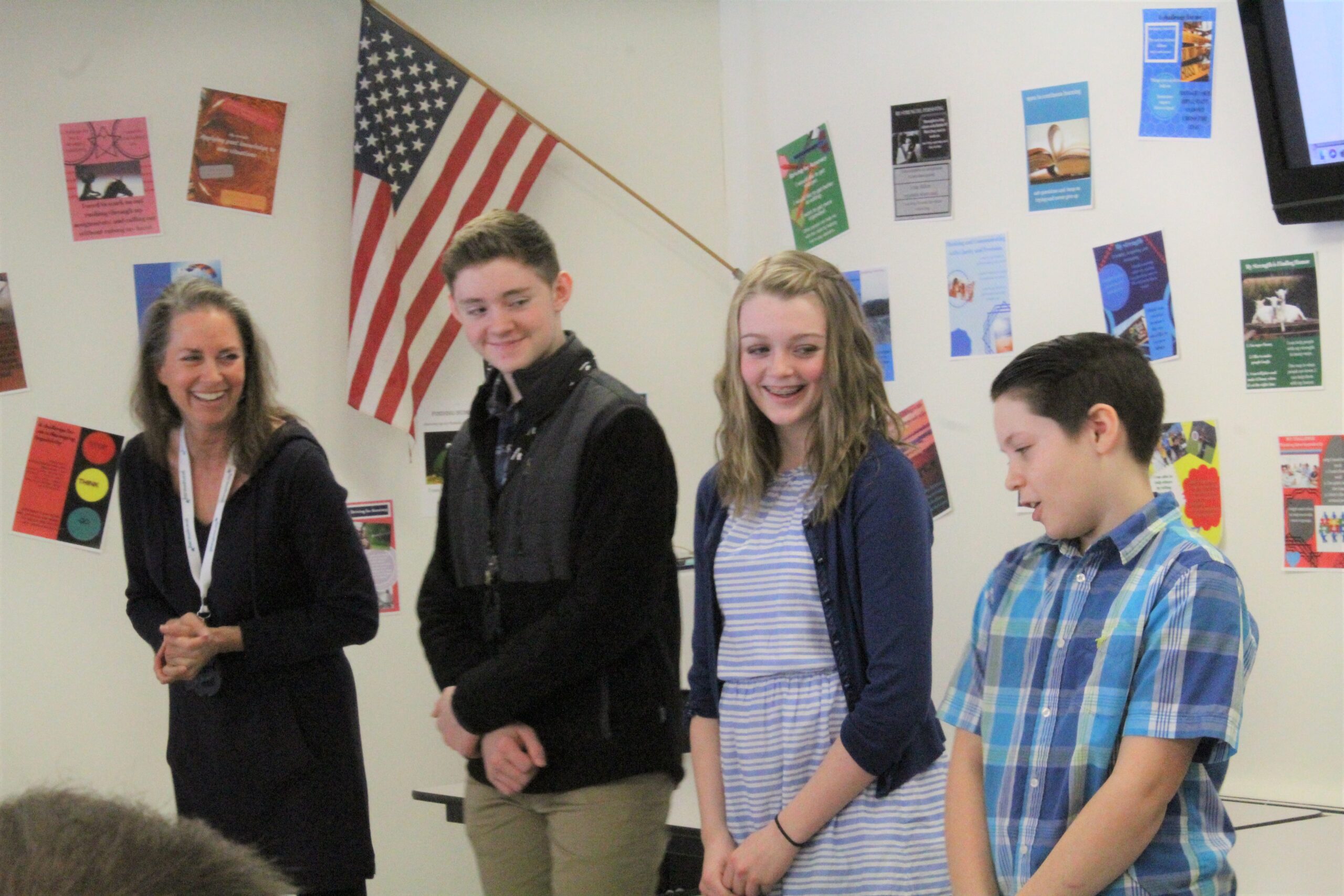

Nathan Frye, center, and Cameron Davis show a Learning Lab attendee how they use Google Forms in the classroom. (Courtesy of Michael LaReux)
DANFORTH, Maine — Educators from across the state met at East Grand School on March 5 to explore the impact of technology in education.
Dubbed the East Grand Digital Learning Lab, the event adopted a new approach to teacher workshops, relying more on personal experience than formal instruction by expert presenters. Many of the main presenters were the students themselves.
East Grand teachers Jill Plummer, Jennifer Gilman, and Kim Gray organized the event in cooperation with Digital Learning Specialist Amanda Nguyen of the Maine Department of Education. Also attending was Ryan Wiggins of Apple Computer, a key partner in Maine’s Learning Technology Initiative.
As Kindergarten teacher Kim Gray put it, technology allows the teacher to “meet the children where they are at.” It is a world vastly different than the one in which she and the other organizers grew up.
Today’s students carry computers in their back pockets with more computing power and storage capacity than the ones that helped send Neil Armstrong to the moon. They have no concept of card catalogs, ditto machines, filmstrips, or overhead projectors.

Norey Caron, left, and Aiden McEwen teach attendees about how they use Flipgrid in the classroom. (Courtesy of Michael LaReux)
It was here, in the gulf between these two worlds, that the Digital Learning Lab was born.
The Lab deviated from the standard workshop model, in which a series of presenters discuss classroom solutions or innovations and the teachers take that information back to their respective schools for implementation.
In contrast, The Lab’s attendees spent the day in actual classrooms, observing students using technology as part of their educational day. Rather than passively listen to experts, attendees experienced firsthand the impact of technology on students, as well as how the teachers use these new tools to reach a generation that has never known a world without the internet.
After the organizers offered opening remarks, the attendees broke into three groups, each led by a student ambassador, who conducted them to the classrooms that showcased specific ways that technology was being integrated into the students’ educational lives.

Apple Representative Ryan Wiggins looks on as young students use iPads to complete their assignments. (Courtesy of Michael LaReux)
In Kim Gray’s kindergarten class, students demonstrated to the visiting educators how they take photos of their work and post it online using iPads and an app called Seesaw. Student work can be viewed by the parents as it is posted, allowing each parent to get instant feedback on their child’s progress.
Many of the educators were reticent at first, preferring to stand back and merely observe the children, but before long the classroom was abuzz with questions. Eager students proudly demonstrated their competence with the classroom iPads as the educators looked on.
In Jill Plummer’s middle school classroom, students gave impromptu lessons on the apps they use every day. The app that received the most attention was Flipgrid, a video discussion platform introduced to East Grand by math teacher Jennifer Gilman early in the school year. The class also showcased Canva, Padlet, and Google Forms, and showed the attendees how they used these apps to complete assignments, noting the advantages and drawbacks of each.
In the high school, Jennifer Gilman and members of the school’s student technology “Dream Team” introduced attendees to the immersive world of Virtual Reality. Sophomore Benjamin Gilman, Junior Bobby Massey, and eighth-graders Madison Napoli and Jathaniel Lindsey discussed the far-reaching implications of this emerging technology. Later, the educators had the opportunity to don the VR goggles, with Dream Team members serving as mentors to help them navigate through programs such as Google Earth VR and ShareCare, an Anatomy and Physiology application that allows users to explore the inner workings of the human body.

Benji Gilman, left, instructs attendees on the proper use of Virtual Reality equipment. (Courtesy of Michael LaReux)
At the end of the day, attendees took time to collaborate and discuss what they’d experienced. Some were amazed at the students’ engagement and the sense of ownership they demonstrated. Others expressed reservations about the drawbacks that come with introducing new technology.
In a final moment befitting a day centered on students, Napoli stated, “I’ve lived in Texas and other states, and I’ve been to lots of different schools, but I’ve had opportunities here that I haven’t had anywhere else, and I want your schools to have the same opportunities I have, and that’s why I did this today.”
The interaction between the attendees and the students blurred the lines between teacher and learner.
In many ways, the Digital Learning Lab was a glimpse into the future, where students will navigate a world that moves in at speeds measured in megabytes per second, and information is never more than a click away. While it’s unlikely that traditional teacher workshops are going the way of the floppy disk, events such as this highlight the changing role of teachers in the classroom, and the nature of education itself.







